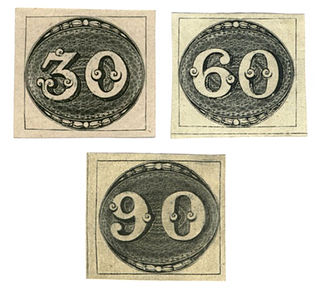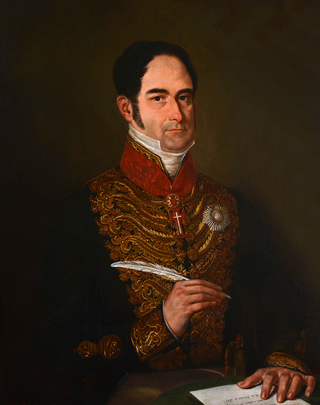
The postage stamps and postal history of British Columbia started in 1860 with the issue of a single brownish-rose stamp depicting Queen Victoria in profile and denominated as 2½ pence. It was issued jointly by Vancouver Island and British Columbia as each colony had insufficient postal trade to justify printing separate stamps. In 1862, Vancouver Island adopted decimal currency and sold the stamp for 5 cents, before issuing its own 5 and 10 cent stamps in September 1865. Meanwhile, British Columbia had increased the postal rate to 3 pence but continued to use the unified stamp. In November 1865, British Columbia issued its own stamps and the unified stamp became invalid. In 1866, the two colonies were united as British Columbia.

José Bonifácio de Andrada e Silva was a Brazilian statesman, naturalist, mineralist, professor and poet, born in Santos, São Paulo, then part of the Portuguese Empire.

The Brazilian Army is the branch of the Brazilian Armed Forces responsible, externally, for defending the country in eminently terrestrial operations and, internally, for guaranteeing law, order and the constitutional branches, subordinating itself, in the Federal Government's structure, to the Ministry of Defense, alongside the Brazilian Navy and Air Force. The Military Police and Military Firefighters Corps are legally designated as reserve and auxiliary forces to the army. Its operational arm is called Land Force. It is the largest army in South America and the largest branch of the Armed Forces of Brazil.

The Bull's Eye(Portuguese Olho-de-boi) postage stamps were the first stamps issued by Brazil, on 1 August 1843, having face values of 30, 60, and 90 réis. Brazil was the second country in the world, after the United Kingdom, to issue postage stamps valid within the entire country. Like the United Kingdoms's first stamps, the design does not include the country name.

The Ministry of Foreign Affairs conducts Brazil's foreign relations with other countries. It is commonly referred to in Brazilian media and diplomatic jargon as Itamaraty, after the palace which houses the ministry. Since 1 January 2023, the minister responsible is Mauro Vieira.

Ângelo Moreira da Costa Lima (1887–1964) was the foremost Brazilian entomologist of his time, and his still-consulted works continue to assure his place in the history of science as the "Father" of Brazilian entomology.

The Political Constitution of the Empire of Brazil commonly referred to as the Constitution of 1824, was Brazil's first constitution, issued on 25 March 1824 and revoked on 24 February 1891. In force during the period of the Empire of Brazil, it was issued at the emperor's request, that is, unilaterally imposed by the will of emperor Pedro I, who had ordered it from the Council of State. Pedro had dissolved the Constituent Assembly in 1823 and, through the Constitution of 1824, imposed his own political project on the country. The same Pedro later issued, in Portugal, the Constitutional Charter of 29 April 1826, inspired by the Brazilian model.

The Armed Forces of the Empire of Brazil were the overall unified military forces of the Empire of Brazil. The Brazilian military was first formed by Emperor Dom Pedro I to defend the new nation against the Portuguese in the Brazilian War of Independence. The Army and Armada were commissioned in 1822 with the objective of defeating and expelling the Portuguese troops from Brazilian soil.

This is a survey of the postage stamps and postal history of Uruguay.

Manuel Alves Branco, the 2nd Viscount of Caravelas was a Brazilian politician, economist, and magistrate during the Empire of Brazil (1822–1889). He held the positions of general deputy, minister of justice, minister of finance, senator and was also the first de jure prime-minister of Brazil.

Coded postal obliterators are a type of postmarks that had an obliterator encoded with a number, letter or letters, or a combination of these, to identify the post office of origin. They were introduced in the United Kingdom of Great Britain and Ireland in 1843, three years after the first stamp was issued. They became common throughout the nineteenth century but very few remained in use until the twentieth century.
Sergio Leo de Almeida Pereira, known as Sergio Leo, is a Brazilian writer, journalist and blogger.

Martim Francisco Ribeiro de Andrada was a Brazilian politician who played a leading role in the declaration of Brazil's independence and in the government the following years. He was twice Minister of Finance.

Angelo Lima, was a philatelist who was a specialist in the philately of the Portuguese area.

The Imperial Brazilian Navy was the navy created at the time of the independence of the Empire of Brazil from the United Kingdom of Portugal, Brazil and the Algarves. It existed between 1822 and 1889 during the vacancy of the constitutional monarchy.

The Imperial Brazilian Army was the name given to the land force of the Empire of Brazil. The Brazilian Army was formed after the independence of the country from Portugal in 1822 and reformed in 1889, after the republican coup d'état that created the First Brazilian Republic, a dictatorship headed by the army.

José Antônio Pimenta Bueno, Marquis of São Vicente, was a Brazilian magistrate, diplomat and politician. He served as Prime Minister of Brazil from 1870 to 1871.

Francisco Jê Acaiaba de Montezuma, first and only Viscount of Jequitinhonha, born Francisco Gomes Brandão, was a Brazilian jurist, diplomat and politician. He was a senator for the province of Bahia from 1851 to 1870, commanded two ministries during the regency of Diogo Antônio Feijó and was president of the Bank of Brazil.



















